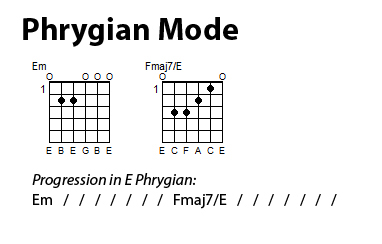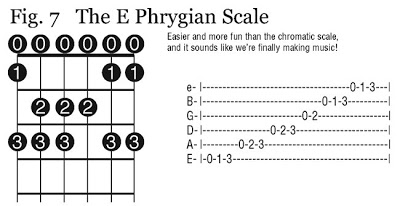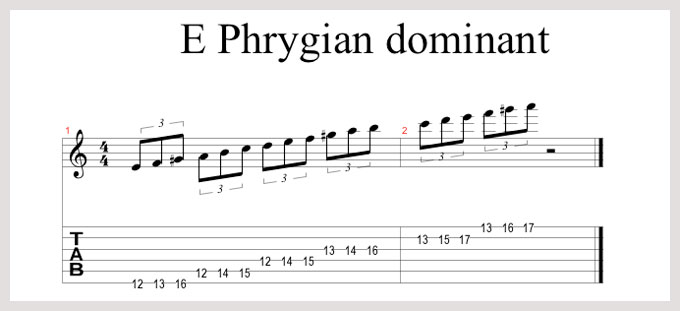
In episode 15a, We look at theory again, specifically with a focus on the benefit of learning scales on one string and the advantages of spending time gaining a good musical knowledge. After this, we examine the Phrygian mode and the Phygian Dominant, which uses the major third instead of the minor third. To experiment with these ideas we improvise over a metal backing track from YouTube.
Dan and I are in the process of producing what I hope you’ll find a really useful set of resources based upon the interesting topic of tone. This will include my actual lesson with Dan, edited into episodes and released as podcasts. This set of podcasts (lesson 16) will support and be supported by an article written by Dan, with all his excellent knowledge and experience on this theme. Then edited, with some additional ideas from me. We don’t know, as yet, where the article will be published, but will include links and additional spin-off articles when we do release the podcasts. We are very excited about this and I, for one, can really attest to how useful Dan’s ideas, demos and advice on this subject really is. Stay tuned and hone the tone.
Before this article and set of podcasts is released, we will also be releasing the last in this set on modes (which doesn’t include the Ionian, Locrian or Aeolian modes). This final episode will be lesson 15b and should be released next week to complete this study. It’s subject is the wonderful, floaty, fanastical Lydian scale which involves the great sounding #4th.
We also, will be releasing a mash-up of the remaining part of lesson 15 and a topic which we covered in lesson 16 in response to Strut who commented on episode 5 and is looking to get a mid-range guitar. This mini podcast will be released at some point over the next week and will involve some discussion about how to set about buying a mid-range guitar, some thoughts about the PRS SE range (also reviewed by Adam Harkus – http://adamharkus.com/prs-se-245-spalted-maple-review/) and finally some further Country mixolydian improvisation.
Lesson 15a brief breakdown:
- 1 minute 30 seconds – start, covering the validity of learning scales on one string.
- 5 minutes 30 seconds – quick thank you to a couple of our SoundCloud listeners who got in touch with us with some very nice feedback 😉
- 11 minutes 10 seconds – Gary’s exercise playing each of the seven modes starting on the 3rd fret of the A string (C), then doing the same for ‘G’ on the E string, then doing the same for ‘D’ on the A string, then the same on ‘A’ of the E string and so on through the circle of fifths to E, B, F#, C#, Ab, Eb
- 13 minutes 27 seconds – Recommendation of NGIS – No Guitar is Safe. Thanks to Jude Gold of Guitarplayer magazine for such an inspirational podcast. The Episode which is mentioned here is Jude’s interview with Rusty Cooley – https://soundcloud.com/guitar-player-magazine/episode-48-rusty-cooley. There are some superb episodes of this podcast.
- 15 minutes 30 seconds – start of study of Phrygian and Phrygian Dominant modes.
- 16 minutes 30 seconds – metal backing track linked below – https://www.youtube.com/watch?v=g8TcuOvmK6Q
- 20 minutes – quick discussion about the difference between Phrygian and Phrygian Dominant modes.
- 21 minutes 45 seconds – backing track again demonstrating the difference between Phrygian and Phrygian Dominant modes.
This episode includes a newly recorded outro. Remember to get in touch with us and don’t hesitate if you’d like to try Skype lessons with Dan.




Other useful videos on this topic:
Quist backing tracks:
Our philosophy:
As a result of some feedback we decided to break our lessons up into two parts, releasing part 1 each fortnight and part 2 the following weekend. Hopefully, this will make the length of the lessons a bit more digestible and bite-size. This may mean that there are references in each part to the other, but we will try to ensure that our lessons have two sections. As always get in touch to let us know your preferences, suggestions and feedback.
We love direct engagement and to show our appreciation you may get a mention: What lessons do you want us to cover? What would you like us to do? How would you like us to develop TITU?
Our podcast and blog has organically grown and we appreciate all feedback, follows, likes and suggestions. It is meant to be used as a way of introducing some ideas and themes which are useful to be aware of as you develop your practice on your guitar. Hopefully, you’ll find them useful in the audio format which we release them in as this way you can listen while doing another task and then use the suggestions we raise in each episode to do some extra research and to inform your own practise. It is our hope that you find this a useful listening exercise, to support the development of your musical ear. It is good to think that you, our listeners, are not immediately looking for tabs, but rather using your ear to find the notes yourself. This is important to develop your feel, phrasing and dynamics.
The way I myself find these lessons useful is to study in great depth what Dan introduces me too, including guidance on who or what to listen to, and I feel lucky that I can return to each lesson and not forget all his excellent advice as was the case prior to the recording of our lessons. I also find studying my own mistakes hugely valuable, I hope you do too.
We plan to continue producing posts for each podcast episode, linking in some guitar lesson videos from online tutors and guitar covers from players out there. I hope that you will find our lessons and blog useful and that we help you to see the big picture. I certainly think that I could have organised my own practice to be more effective earlier in my own learning and if this had been the case, then I would have developed my skills more quickly and easily. For further ideas about this we encourage you to spend some time looking at my article on guitar practice, apps and software and then dedicate some time NOW into learning to recognise intervals, rhythms and chords by ear. This will hugely fast-track your learning.
I hope you enjoy this lesson as much as I did and that you keep listening. If you want to support us further, then like us on Facebook, follow us on SoundCloud, Twitter or Google+ and subscribe, rate and review on iTunes to help us conquer the Apple algorithms. You can also follow my online magazine: Lessons and Gear for Guitar Geeks and Fanatics.
Good luck on your musical journey!
Gary and Dan.
